In one of my previous posts I talked about the trek of the great-aunts and the plaque erected in the church to honour them. One of the first things I researched after our trip to Burma was the history of the church, what little there is. I picked up references to it in B.R. Pearn’s ‘A History of Rangoon,’ and in Colesworthy Grant’s ‘A Rough Trip to Rangoon in 1846.’ I referred to Liz Chater’s excellent blog, Chater Genealogy which is full of information about the Armenians in India. It will be an ongoing project to explore on my next trip to Rangoon, which is coming up soon.
The Armenian Apostolic Church of St. John the Baptist, in Rangoon, Burma
This church is the second to be built by the Armenian community. The first one was not far away on the site of the Law courts, built by Gregory Avas (see note 1 below) with local bricks and a wooden spire, in ca1766.
This was most likely a grant of land from the East India Company, who were so desperate to get their hands on Persian silk they rashly granted all Armenian traders and their families the right to be treated as British subjects in every way, as well as to be given free land for a wooden church to be built at the EIC’s expense if they numbered more than 40, until the community could erect a church of a more substantial nature. (See note 2 below)
There were other churches in Syriam, Mandalay and Ava, but few traces remain. A traveller in 1836 thought Rangoon was nothing but a ‘neglected swamp,’ with huts of thatch and bamboo, a few wooden houses and only five small brick places of worship – an Armenian church, 3 mosques and a Roman Catholic Church. The only other large building was the brick, wood and thatch house of Mr. Manook, the most important Armenian merchant.
The wooden spire of the original Armenian Church, built in 1766, rises in the background of Rangoon. From ‘A Rough Trip to Rangoon in 1846’ by Colesworthy Grant
The British Government of India sent Lt.-Col. A. P. Phayre (later Sir Arthur Phayre) to oversee the building of a new city on the swampy site of Rangoon in the early 1850’s and all existing land immediately became property of the government. People were allowed to stay, or even squat on unoccupied lots, paying rent, until the government had drawn up the city plan – then the lots would be up for sale or lease. Despite many petitions or ‘memorials’ as they were called proving the validity of previous contracts, land sales and grants, all deals were off. Instead, a free grant of land was given to all churches, exempt of purchase price and exempt from taxation. The Armenians were given this site, the southwest corner of Merchant and Sparks streets. All the records of this church have been lost, so we do not know who designed it. The land was given circa 1853, listed in Thacker’s Indian Directory as being founded in 1858, then finally consecrated on January 17th, 1863. The officiating priest was Revd. Father Aviet Chaytor.
It makes the most of a high roof and Gothic arch pointed windows. The concessions to the tropical climate are the covered entrance porch and side porch, which serve in both the hot sun and torrential monsoon rains. The pews are not solid but cane seated, another nod to the heat. The bell, which is still rung by hand during the weekly Sunday service, was cast in England. The roof was redesigned in 1908/9.
During the Second World War the church suffered some damage to its roof. It was repaired and rebuilt, the result of which can been seen today.
Presently all properties in central Yangon are being eyed by developers and this large church property which also has an overgrown garden is no exception. It was never put on the Heritage list in the 1990’s. Please contact the Yangon Heritage Trust at yangonheritagetrust.org if you would like to see it survive.
A list of previous priests, wardens etc. of the church
Nearly all of the information in this table, never previously published, comes from the Thacker’s Indian Directories in the British Library. I spent many hours turning the tissue thin pages, absorbed by the depth of information contained within, and collected all the names and dates referring to the Armenian Church in Rangoon.
The spellings are as found in the directories. Note that the church lists itself in 1917 as being founded in 1858 and there is an address change in 1931. Any blanks are because no information was submitted that year, or the directory was missing.
Priests of the Armenian Church in Rangoon 1844-1941
Reverend K Felix, officiated from 1978 to 2011.
Links to other articles about the church (will be updated as I discover more of them):
From the BBC, Aug. 27th, 2014:
http://www.bbc.com/news/magazine-28867884
From the Irrawaddy Magazine Oct. 1, 2014
http://www.irrawaddy.org/feature/burmas-last-armenians-eagerly-await-visit-supreme-patriarch.html
Notes:
Note 1 – This was most likely Gregory of Ava, mentioned in letters in the East India Company’s archives as an adviser to King Alaungpaya. Gregory did everything he could to frustrate the EIC’s ambitions to trade in Burma, from mis-translating their letters to the King, to whispering in his ear rumours of EIC soldiers and armed ships using the factories (trading posts) to conquer the country. His machinations played a large part in the massacre at Negrais.
Note 2 – Although this happened in many areas where the EIC had a factory, including Singapore, subsequent research has proven it was not the case here. King Alaungpaya granted the land to the Armenian community in the 1750’s, after he established Rangoon as a favoured port to replace Syriam which was quickly silting up.

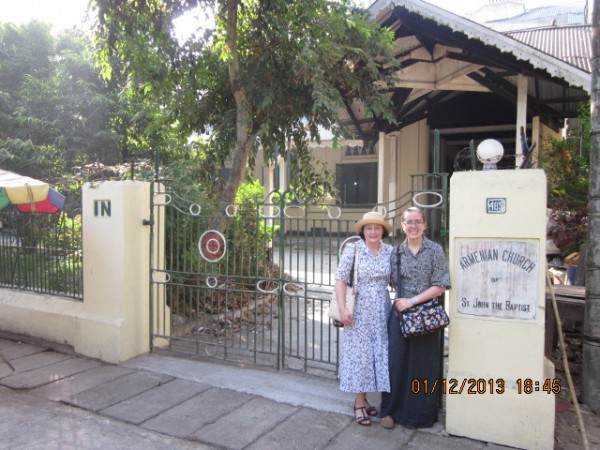
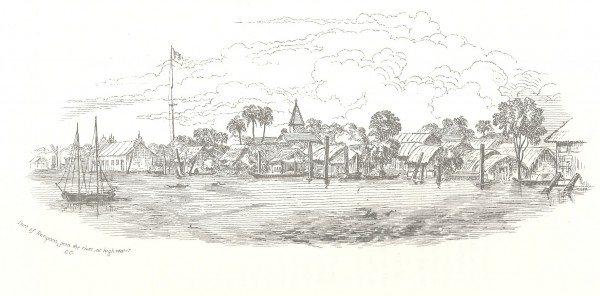
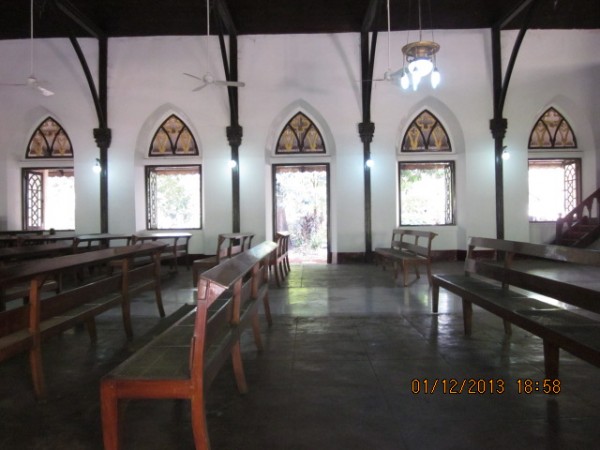
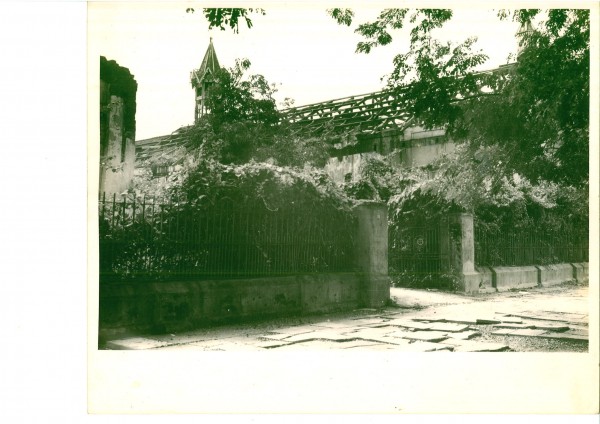
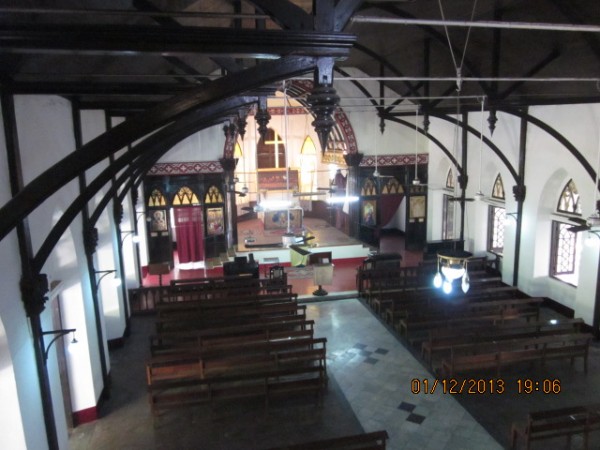
I was very excited to get this link from my friend. Liz Chater. She came across this will leaving a bequest to the Armenian Church in Rangoon, dated 1852. The interesting item is the newspaper cutting. In December 1850 there was a savage fire in Rangoon which more or less destroyed the centre of the city, including the little wooden Armenian Church, seen in the drawing in my post above. I always wondered why the location changed, and now we know. Please read Liz Chater’s post below:
http://chater-genealogy.blogspot.ca/2014/09/armenians-in-rangoon.html
Como armenio que soy esta Iglesia debe preservarse y mantenerse, sea por parte de la Iglesia Apostólica Armenia, y también por el estado y gobierno de Myanmar (Birmania),es un pecado que nuestros antecesores hayan construido esta Iglesia para la Adoración de Nuestro Señor y ahora emprendimientos comerciales se apoderen aviesamente de nuestros sitios históricos y religiosos.
Thank you for your comment. I have translated it into English, if you don’t mind, because many of us have the same opinion.
Translation:
As an Armenian I think this Church should be preserved and maintained, either by the Armenian Apostolic Church, and/or the state and government of Myanmar (Burma.) It is a sin that our forefathers have built this church for the Adoration of Our Lord and now commercial enterprises are maliciously taking over our historical and religious sites.”
Hi ,
i will be visiting Yangon in May and i would lobe to visit this church 🙂 can someone please help me with contact details for the church or address
God bless
regards Simon
Hello Simon,
The address is 66 Bo Aung Kyaw Street, or the corner of Merchant and Sparks in the old nomenclature. It’s about a 10 minute walk southeast of the Sule Pagoda. Merchant Street runs Parallel with the Strand.
I came across the Armenian Church in Yangon quite by accident on 23 November 2016. I was invited in to view it by Richard Minus, a Trustee of the church and a descendant of one of the original Armenian families that settled in the city. The building is undergoing lengthy restoration so is in a little disarray but there is a small display charting the history of the Armenians in Yangon, which I found very interesting. their contribution to the city has been out of all proportion to their numbers. The church is a lovely haven from the hustle and bustle of the surrounding streets and well worth a visit.
Thank you for your comment. It truly is a haven in the centre of a busy area. Richard Minus and family have been, at times, the only congregation, but now it is increasing. The Armenians who settled in Burma did, indeed have an effect far beyond their small numbers.